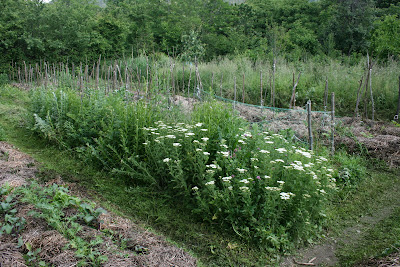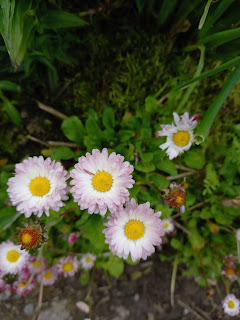It's Sophie here writing from Wales again and here to share an excellent local food growing project, I've been helping out with, Einion's Garden.
Welcome to part 1 of a part mini-series I plan to write about the interesting gardens and projects that I visit in West Wales. It's always a joy to roam around the Dyfi Valley and I'd always wanted to visit Einion's Garden, run by John and Ann, as my good friend Susannah volunteers there every Friday and I'd heard a lot of good things about it. I'd also seen a video presentation by Ann before on what plants tend to do well in the local area. It was wonderful to get the chance to volunteer and visit in person, just as the growing season was getting underway.
The garden is located on the main road between the town of Machynlleth and the city of Aberystwyth, in a village called Furnace, easily accessible yet with a very rural feel, surrounded by rolling hills. Two polytunnels packed full of different species of annual and perennial crops greet you as you enter the plot.
.jpg) |
| Susannah preparing a bed outside the polytunnels |
 |
| Inside one of the two polytunnels. A fig tree not yet in leaf sits in the center bed |
The relatively mild winters experienced in this region mean that there are usually always fresh greens available to eat then, although likely not enough to send to market. Einion's garden offers their products in a local veg box scheme which other growers also contribute to, local food co-operatives, and in some local shops. They also mentioned that they are part of an emerging food system that is a possible model for a lower carbon future, but more on this coming up in the second post as I hope to uncover more details when John and Ann are a little less busy with garden work :)
 |
| Scrumptious green goodies :) |
The productive beds are mainly next to and behind the polytunnels, laid out in a rectangular formation with pathways, not dissimilar to how we have laid our own beds out in our Market Garden, Aponia. Our raised beds are each 23m x 1.2m and approximately 30cm high with 50 cm paths between the beds. These dimensions enable easy access to the soil and plants without ever having to tread on the beds.
 |
| The raised beds in Aponia |
 |
| Early season in Aponia, our market garden. The productive annual beds are surrounded by lots of different habitat types and the boundary is a hedge of native trees and shrubs, including many Prunus insititia - Damson trees |
 |
| Einion's Garden is also flanked by native trees and shrubs |
.jpg) |
| Diversity of flowering plants on the edges of the productive beds at John and Ann's |
It's a good idea to factor pollination support into our designs, and one idea that could work for a rectangular bed formation is to design a combination of flowering plants in a strip and repeat this throughout the bed every 4m or so. If plants with different flowering times are selected hopefully the pollination support they provide can be maximized as the polyculture can be designed to feature plants whose bloom times overlap to always have flowers available to pollinators.
We have also experimented with leaving a section of our annual productive beds to go fallow. The benefits of leaving land fallow to improve the fertility of the soil have been well known by growers ever since humans started growing and a wide range of beneficial organisms love these plants.
 |
| The power of ecological succession is quite remarkable! |
Here's a more detailed look at a few of the plants I found growing in the strip at the edge of the productive beds at Einion's Garden.
Borago officinalis - Borage
Bellis spp. - Daisy
Overview: Daisy grows up to 0.2m and is hardy to USDA zones 4 -8. Frequently found in lawns and meadows, it's an easily grown perennial that prefers a sunny outlook and good drainage. A good ground cover plant. It blooms from early spring until late autumn from May-August and the flowers may be eaten and are often added to salads. Butterflies, bees, and other types of flies enjoy visiting the blooms.
Allium schoenoprasum - Chives
Overview: Chives are a bulbous perennial plant growing up to 0.3m and hardy to USDA zones 3-9. They like to grow in rocky pastures and damp meadows, generally preferring calcareous soils. They grow well with most plants, especially roses, carrots, beet, and chamomile, but may inhibit the growth of legumes. Beautiful purple flowers are much loved by pollinating insects such as bees and wasps and like other Alliums, the plant is said to have pest-resistant properties.
If you are interested in looking into pollination support in greater detail you might like to check out The Early Polleniser Polyculture which aims to provide pollination support for farms and gardens, nutritious fruits and nuts, valuable nesting sites for endangered native bees, and spectacular flower displays to shake off the winter blues :)
Support Our Project
If you appreciate the work we are doing you can show your support in several ways.
Become a member of the Bloom Room. A $70 annual or $7 per month subscription to our Substack provides you with access to live sessions, design tutorials, a members forum and more, see details here.
Make a purchase of plants or seeds from our Nursery or Online Store
Joining us for one of our Practical Courses or Online Courses
Comment, like, and share our content on social media.
If you appreciate the work we are doing you can show your support in several ways.
Become a member of the Bloom Room. A $70 annual or $7 per month subscription to our Substack provides you with access to live sessions, design tutorials, a members forum and more, see details here.
Make a purchase of plants or seeds from our Nursery or Online Store
Joining us for one of our Practical Courses or Online Courses
Comment, like, and share our content on social media.

.jpg)
.jpg)

.jpg)





Cool
ReplyDeleteNeat
ReplyDelete